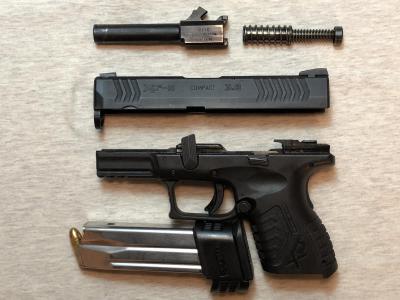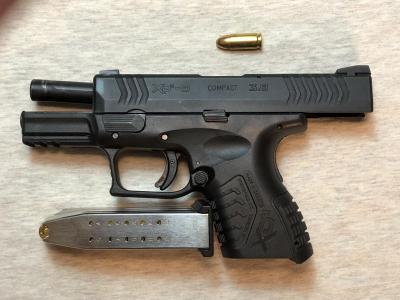Part 1: Handgun Safety, Parts and Operation
Safety knowledge
The major causes of gun accidents are ignorance and carelessness
- Always keep the gun pointed in a safe direction
- Always keep your finger off the finger until you are ready to shoot
- Always keep the gun unloaded until you are ready to use
Three major handgun parts

Barrel
- Metal tube through which the bullet is fired
Frame
- Backbone of the gun to which other parts are attached
Action
- Group of moving parts used to load, fire and unload the gun
Handgun parts detail
- Front and rear sights - Together, the sights are used as tools to align the gunshot to the target
- Slide - On a semi-automatic handgun, the slide provides the action of loading a cartridge, and ejecting the casing when fired
- Slide lock - The lock hold the slide in the open position when the gun is empty
- Trigger and guard - The trigger is the part of the action that initiates the firing process, and the guard protects the trigger if the gun is dropped
- Magazine - On a semi-automatic handgun, the magazine holds and feeds the ammunition into the barrel with the help of the slide
- Safeties - There are multiple safety types offered on handguns design to prevent the gun from firing accidentally
- Hammer, striker and firing pin - These parts, depending on the gun, combine to strike the cartridge primer which burns the gunpowder and discharges the bullet
- Barrel - The barrel contains the firing chamber, and length of tubing through which the bullet is discharged. Barrels are designed with various lengths and diameters depending on the handgun specification
Handgun operation
Loading
- For a semi-automatic handgun, load cartridges into the magazine
- Keep the gun pointed in a safe direction with your finger off the trigger and the slide locked back
- Firmly insert magazine into the magazine-well
- Release the slide to load a cartridge from the magazine
- Maintain safe control of the gun as you prepare to fire
Unloading

- Maintain the gun in a safe direction with finger off the trigger
- For a semi-automatic handgun, always release and remove the magazine first
- Next, draw back and lock the slide to empty any cartridge in the chamber
- Visually inspect the chamber to ensure it is clear
De-cocking
- For a semi-automatic gun, some include a de-cocker feature
- Depress the de-cocker lever to take the gun safely out of ready-to-fire condition
- De-cocking a gun that has an external hammer can be accomplished by slowly lowering the hammer with your weak hand thumb between the hammer and slide to prevent an accidental hammer drop. This approach requires coordination between the trigger and hammer to initially unlock the hammer
Part 1 Practical exercise
What are the three rules of safe gun handling
- Always keep the gun pointed in a safe direction
- Always keep your finger off the finger until you are ready to shoot
- Always keep the gun unloaded until you are ready to use
Identify the three major semi-automatic handgun parts
Name three gun loading operations
- Loading
- Unloading
- De-cocking

